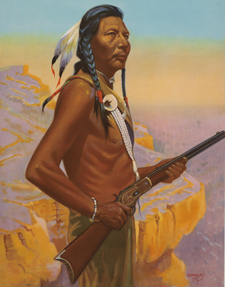
Vanished Worlds, Enduring People
Sideshow to Powwow
Europeans quickly grasped the value of Native Americans as entertainers. George Catlin often brought “real” Indians to pose alongside his gallery of portraits in the 1830s and 1840s. Groups of Iowas and Ojibwas joined him in Europe, demonstrating archery, ball play, and dancing. Catlin exhibited his portraits of Native Americans throughout Europe and America, often lecturing about the diversity of native cultures, and about the negative effects of unbridled American territorial expansion on Indiana lands and communities.
Troupes of native performers were on the road when William F. “Buffalo Bill” Cody started his popular Wild West shows in the 1883. Cody, a showman, capitalized on the dramatic potential of portraying “authentic” events he had witnessed. Indians were employed to enact their part in “history” as interpreted by Cody. Arguments that he was exploiting native show members and glorifying warfare started almost immediately, and continue today.
Confined to reservations in the late 1800s, Native Americans reaffirmed their cultural identities together through music and dance. Local powwows began in Plains communities as secular dances. Today, powwows and other gatherings, powerful public affirmations of Indian identity, are conducted throughout North America for appreciative native and non-native audiences.